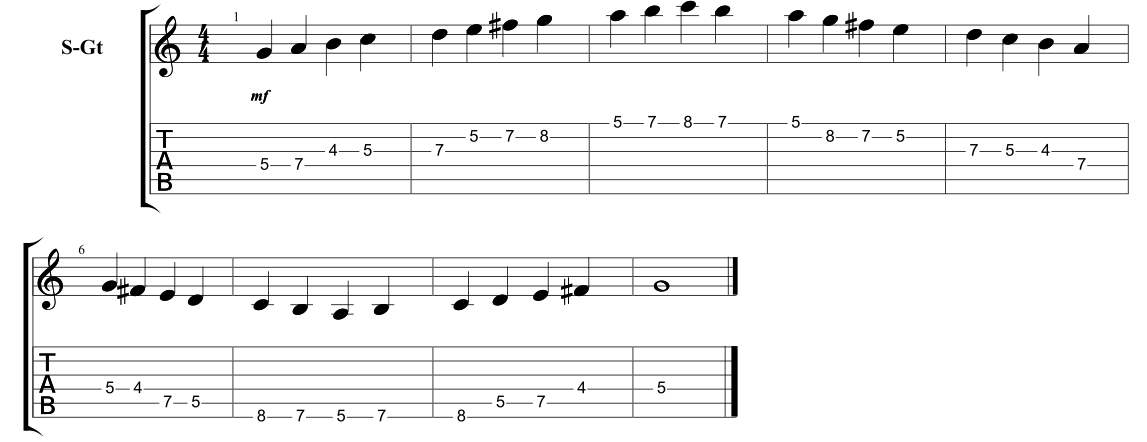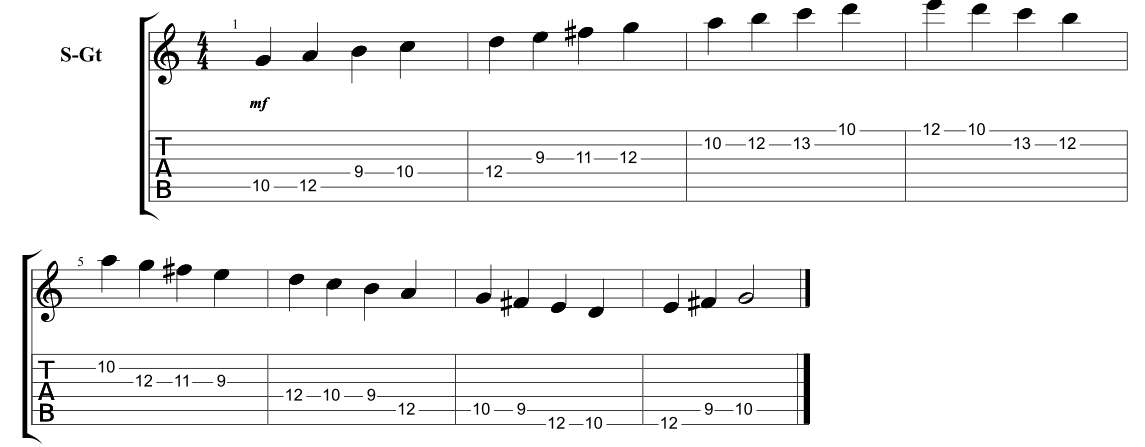March 18, 2022 by Klaus Crow

Photo by Bigstock photo
If you know how to play the major scale in one position and you’re ready to learn to play it all over the fretboard then this lesson is the next step.
If you haven’t played the major scale before you might wanna check out this post first: How to Play The Major Scale Guitar Guide for Beginners and Intermediate.
The major scale is the mother of all scales and your reference point for all other scales. That’s why it’s so important to master all of these five scale shapes.
The five C-A-G-E-D scale shapes (C shape, A shape, G shape, E shape and D shape) surround the entire fretboard. The “shapes” are sometimes also referred to as “positions”. In this post we use the G major scale as an example. So all five scale shapes (see below) are G major scale.
You can apply these scale shapes to all 12 keys by simply moving the shapes up or down the fretboard. For example: If you move the five shapes up a whole step (2 frets) then all the shapes are in the key of A, so you have five A major scale shapes.
The five scale shapes are derived from the CAGED system. If you’re not sure what the CAGED system is all about check out: What is The CAGED System? (The Keys to The Fretboard)
Each scale shape is related to a chord shape and surrounds that chord shape so you can easily identify the name of each scale shape. In each diagram below you can see the scale shape and the chord shape (made up of the red and green dots) that is surrounded by the scale shape.
PLAYING THE SCALE SHAPES / POSITIONS
If you look at the diagrams, play each scale shape starting from the lowest root note (the red note) then play all the way up (ascending) to the last note on the high E-string, then play all the way down (descending) to the first note on the low E-string and then play up again to the first root note you’ll hit upon. The tablature shows you how to play each scale shape ascending and descending.
Tips
– Practice the scale shapes with a pick using alternate picking technique (down, up, down, up, etc.)
– Practice slowly first and make sure each note sounds clean and clear.
– Try to visualize the chord shape in each scale shape.
– Make sure you can play each scale shape thoroughly before moving on to the next.
– Be patient and persistent, it takes some time to get them all under your belt.
– Repetition and regular practice is the key to success!
Have fun!
G Major Scale – E Shape / Position 1


G Major Scale – D Shape / Position 2


G Major Scale – C Shape / Position 3


G Major Scale – A Shape / Position 4


G Major Scale – G Shape / Position 5


Follow me on Instagram and reach out to me in the comments below. I’m real! :)
Suggested fingerings for each of 5 positions would be extremely helpful. Your favorites especially. I’m inclined to try so many variations that I never master most of them.
Joe
Hi Joe,
I’ll will soon make a video lesson on the topic.
Best regards,
Klaus Crow
Caged is simply just a way to play all over the neck. I don’t like this methodology. It’s confusing to say the least. There’s more than 1 way to skin a cat though!
hi man thank you for your help i have arthritis and need to do finger exercise what better way than playing lead guitar ive subscribed to you on your youtube channel too thanks so much your a great teacher
Lazy guitar students will always stop learning barre cords, when they master the E and A shapes of the decending pentatonic scale: C-A-G-E-D (-C). It takes five notes to be a pentatonic scale, and it takes five chord shapes and a capo to understand the song “Here comes the sun” by George Harrison. Notice the difference between chord shapes and chords. Just because you fingers most likely won’t let you play those new barre chords, doesn’t mean that you shouldn’t practice visualizing them on the fretboard. By mastering the Caged system, you may discover a very cool thing called “recycled licks”. CAGED also comes handy for those who wants to check out some alternative tunings. Root-2-3-4-5-6-7. Mastering shit like that eventually will make you the most wanted guitarist on the planet.
Would be have been nice to be able to print the shapes out so you could practise them offline
Thanks Klaus. I have become more enlightened about playing guitar since i stumbled on this site. Please keep up the goos work
Very helpful
I think that if all the chord shapes in the different positions were ALL highlighted the same color, exclusively, it would make it easier to see.
Thank you Klaus!!!
I really like the red root dots and the green dots, they show the chord shapes really clearly. These shapes are as the chord would be played down at the nut. Cowboy chord shapes but barred so they can be moved up and down the neck. A hard stretch to bar and play the G and C chord shapes but for lead soloing its not a problem. Plus these shapes can be played as partial chords. Its just a memory aid, helps locate notes and patterns.
Why the position 2 is G major scale?
The notes are: F# G# A B C# D# E F#, this is E major.
Similarly, all positions other than the first are not G major.
What frets are those G scale positions at?
Hi James,
The tabs and the video will show you where you start each scale position.
Best,
Klaus
It begs the question: why is Position #1 the E shape? I means we should call it the EDCAG approach to scales, right?
Great Job Klaus and thank you.
How come there’s no major scale position starting with the 4th note, C in this example of the G major scale?
It’s confusing that the scale position starting with the 5th note, D in this example, is labeled the 4th position and the position starting with the 6th note, E, is labeled the 5th position.